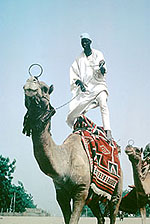
İ2001-2002: Africa Focus
|
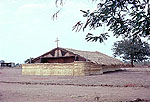
Catholic Church
İ2001-2002: Africa Focus
|
|
|
Chad brings together two very different regions. The huge northern area is a desert region inhabited by nomadic Muslim pastoralists, while the south is populated by sedentary farmers who practice indigenous religions or Catholicism. The most numerous group is the Sara. Chad is almost desert country, but has several arms flowing of the Niger River, where such plantations are able to flourish. Khalil is one of the very few who has succeeded in creating a plantation. This is an example that shows also "little" initiatives can be found in the most remote areas of the continent. This proofs that investments in Africa can be fruitful. Khalil has a good business and is able to take care of his large family. Although all along this river the same plantations can be set up, the local population does not know how to do so, and do not have the means to do so.
|
N'Djamena:
|
N'Djamena is the capital city of Chad. Lying in southwestern Chad at the confluence of the Chari and Logone rivers, the city was formerly known as Fort-Lamy. The city traces its origin back to 1900. N'Djamena suffered badly during the civil war and today, in spite of reconstruction efforts, there are still bomb-sites. However, it is an important market and commercial site as it lies in the cotton-growing, cattle-raising and fishing area. There are also various financial and light-industrial firms. The commercial and Muslim districts are bustling as is the market. The city has a population of well over half a million with the main languages being French and Arabic. Important buildings and institutions in the city include the University of Chad, National School of Administration, National Museum.
|
|
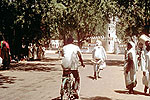
N'Djamena
İ2002: Africa Focus
|
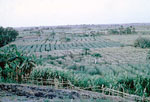
Grainfields
İ2002: Africa Focus
|
|
Economy:
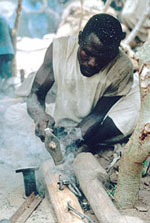
Blacksmith
İ2001-2002: Africa Focus
|
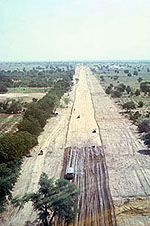
Highway
İ2001-2002: Africa Focus
|
|
|
Chad has potential wealth with important deposits of uranium, wolfram and cassiterite, gold, oil, iron and bauxite. On Khalil Djalal Plantation close to N'djamena you will find an Arabic Gum tree and a Lemon / Orange tree plantation in the middle of nowhere. The recent discovery of oil fields in southern Chad presents the country with new challenges and opportunities.
Exploitation of oil resources could lead to an increase in government revenue, and thus improve the government's ability to address the priority needs of its impoverished population. The government has reached an agreement with a consortium of petroleum companies (comprising Exxon, Shell, and Elf) to extract the oil, which would be piped to the Cameroonian port of Kribi for export. Private sector funding for this project is estimated at over US$3 billion.
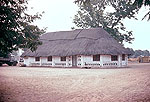
Colonial House
İ2001-2002: Africa Focus
|
|
History:
|
From 1897 to 11th August 1960, Chad fell under French domination. At Fort Fureau (Kouseri), French troops defeated the Sudanese adventurer Rabij az_Zubayr, who controlled areas east of Lake Chad. The city got its name - Fort Lamy - from a French major who died in the battle. From then on, Fort Lamy and Chad remained under French control. During the Second World War it was one of the bases of France Libre. The Parti Profressiste Tchadien (PPT) was the first nationalist movement. In 1956, Chad gained internal autonomy for the country from the French. Ultimately, Chad gained independence in 1960.
The passage from colonialism to independence occurred without violence, and the president, Francois Tombalbaye, was nominated by the French. He was of Sara origin and was soon accused of favouring the Sara. The north rebelled and the government of Chad asked France for assistance to quell the rebellion. Chad then went through about 3 decades of violent conflicts. The rebels, associated in the National Liberatio Front Frolinat, guided from Algiers by the socialist Abba Siddik, put up a strong resistence, and in 1969 France withdrew from the conflict.
On the 13th April 1975 a military coup overturned the government of Tombalbaye and brought to power Felix Malloum at the head of a military giunta. The new regime established an appearance of tollerance and for the first time there was talk of reconciliation. However civil war broke out again, supported in the north by Libya under Ghedaffi. N'Djamena received its current name in 1973, and was under Libyan control in 1980-81. The civil war continued and in 1982 Mr Habre was inaugurated as President, but fighting continued and in 1984 the use of Libyan forces to back the northerners provoked French intervention. Multi-party politics were legalised in 1991. Chad's first Presidential elections since independence took place on 2 June 1996 and President Deby won a five year mandate.
|
|
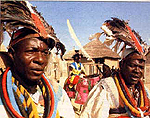
İ2002: Tourist Office
|
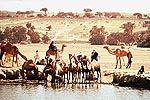
İ2002: Africa Focus
|
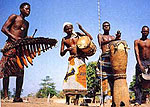
İ2002: Tourist Office
|
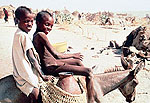
İ2002: Tourist Office
|
|
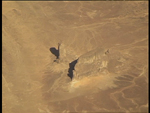
From 31,000 feet
İ2002: Willem Tijssen
|
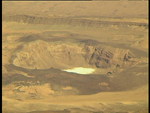
From 31,000 feet
İ2002: Willem Tijssen
|
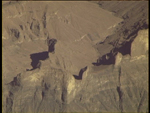
From 31,000 feet
İ2002: Willem Tijssen
|
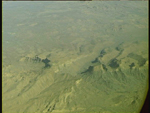
From 31,000 feet
İ2002: Willem Tijssen
|
Today, the country is emerging from three decades marked by periods of civil war and foreign intervention. Since coming to power in late 1990, President Déby has successfully managed a difficult transition to political reconciliation, peace and democracy, but the human rights situation in Chad is poor.
Enabling us to improve the quality of the content, if you have additonal information, remarks or suggestions, please share it with us by e-mail.
Last update: 24 April 2008
11 July 2002: After a 25 year quest French scientist Michel Brunet of the University of Poitiers recently unearthed in the desert in Chad an approximately seven million years old human-like skull, which is being described as the most important find of its type in living memory. Sahelanthropus tchadensis, as the find has been named, may turn out to be a direct human ancestor or it may prove to be a member of a side branch of our family tree. The Sahelanthropus has been nicknamed Toumai, a name often given to children born in the dry season in Chad. Scientists say it is the most important discovery in the search for the origins of humankind since the first Australopithecus "ape-man" remains were found in Africa in the 1920s. The newly discovered skull finally puts to rest any idea that there might be a single "missing link" between humans and chimpanzees, they say.
|